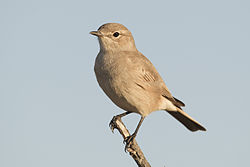| Chat flycatcher | |
|---|---|
 | |
| In Etosha National Park | |
| Scientific classification | |
| Kingdom: | Animalia |
| Phylum: | Chordata |
| Class: | Aves |
| Order: | Passeriformes |
| Family: | Muscicapidae |
| Genus: | Agricola |
| Species: | A. infuscatus |
| Binomial name | |
| Agricola infuscatus (Smith, A, 1839) | |
| Synonyms | |
Bradornis infuscatus Contents | |
The chat flycatcher (Agricola infuscatus) is a small passerine bird in the Old World flycatcher family Muscicapidae that is native to southern Africa.
